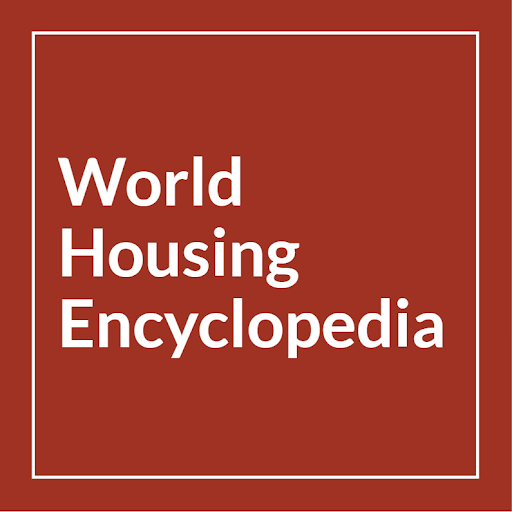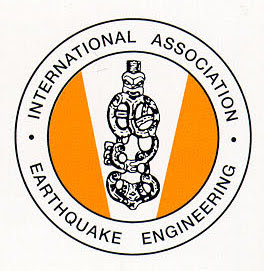This is an old revision of the document!
Traditional adobe house, Argentina
From World Housing Encyclopedia

General Information
Report: 2
Building Type: Traditional adobe house
Country: Argentina
Author(s): Virginia I Rodriguez, Maria I Yacante, Sergio Reiloba
Regions Where Found: Buildings of this construction type can be found in in the province of San Juan. This type of housing construction is commonly found in rural areas. The building code allows this type of construction only in rural areas. However, as the city has grown, the current urban area now includes adobe block constructions that were built in the past (when the area was rural).
Summary: This construction type is a single-family house. In general, it is a single-story building, an isolated construction found in the rural areas of San Juan and Mendoza. The traditional adobe block masonry walls are reinforced with foundations and plinth structure, which provide structural strength. A deficiency in this type of construction is that the adobe blocks deteriorate due to prolonged exposure to humidity.
Length of time practiced: 76-100 years
Still Practiced: Yes
Building Occupancy: Single dwelling
Typical number of stories: 1
Terrain-Flat: Typically
Terrain-Sloped: 3
Comments: This is a traditional construction practice that has been practiced in San Juan for many years, but since 1948 it has been pract.
Features
Plan Shape: Rectangular, solid
Additional comments on plan shape: The typical shape of a building plan for this housing type is rectangular.
Typical plan length (meters): 12
Typical plan width (meters): 8.4
Typical story height (meters): 3
Type of Structural System: Masonry: Earthen/Mud/Adobe/Rammed Earth Walls: Mud walls with horizontal wood elements
Additional comments on structural system: The vertical load resisting system is adobe block walls. The earthquake-resistant system consists of adobe block walls of 40 cm thickness, which generally meet the quality standards and architectural requirements (small openings, heights shorter than 3 m). In general, the roofs are light (weight less than 150 kg/sq m). On the upper part of the wall, there is a reinforced concrete bond beam, and on the bottom there are foundations and plinth structure.
Gravity load-bearing & lateral load-resisting systems: 40-cm-thick block walls joined using mud mortar.
Typical wall densities in direction 1: 10-15%
Typical wall densities in direction 2: 15-20%
Additional comments on typical wall densities: The total wall density is 0.215; it is 0.153 in the X-direction and 0.11 in the Y-direction.
Wall Openings: The typical house has approximately seven openings, with an average area of 1.60m2 . These openings are: 5 (five) windows, placed in the middle of the walls, and 2 (two) doors. The doors are placed to one side of the wall. The opening area is about 10.40% of the whole wall area.
Is it typical for buildings of this type to have common walls with adjacent buildings? No
Type of Foundation: Shallow Foundation: Reinforced concrete strip footing
Additional comments on foundation: Concrete, with a minimum cement of 180 kg/sq m and 30 % of stone. The top of the plinth is 30 cm above the ground level.
Type of Floor System: Other floor system
Type of Roof System: Roof system, other
Additional comments on roof system: The roofing system consists of mud and cane roof with exterior finishing of clay tiles supported by round logs. The roof is considered to be a flexible diaphragm with a maximum weight of 150 kg/sq m.
Additional comments section 2: When separated from adjacent buildings, the typical distance from a neighboring building is 5 meters.
Building Materials and Construction Process
- Description of Building Materials
<html> <table>
<tr> <th>Structural Element</th> <th>Building Material(s)</th> <th>Comment(s)</th> </tr> <tr> <td>Wall/Frame</td> <td>Wall: Adobe blocks/ Reinforced concrete Frame: Reinforced concrete</td> <td>Wall- Characteristic Strength: 3 Kg/sq cm - 10 Kg/sq cm Mix Proportion/Dimensions: Clay soil and thatch Joined with mud (1) resistance to compression (2) resistance to deflection Frame- Characteristic Strength: 200 kg/ cm22400 kg/ cm2 Mix Proportion/Dimensions: 1:3:3 (cement-sand-gravel) Top reinforced concrete beam as wide as the wall (3) resistance of concrete to compression (4) resistance of steel to tension Frame- Characteristic Strength:200 Kg/sq cm-2400 Kg/sq cm Mix Proportion/Dimensions: 1:3:3 (cement-sand-gravel) Top reinforced concrete beam is as wide as the wall. High resistance of concrete to compression, and of steel to tension.</td> </tr> <tr> <td>Foundations</td> <td>Concrete with stone</td> <td>Characteristic Strength: 150 kg/ cm2 Mix Proportion/Dimensions: 1:3:5 & 3 (cement # sand # pebble and stone) Minimum 180 Kg/sq cm, 30% stone</td> </tr> <tr> <td>Roof</td> <td>Round logs with cane and mud roof</td> <td>Round log d=16 cm, every 60 cm Roof maximum weight: 150 kg/ m2</td> </tr>
</table> </html>
- Design Process
Who is involved with the design process? Other
Roles of those involved in the design process: In the beginning, this type of construction was designed and built by engineers and general builders, but later the same construction began to be made by the owners.
- Construction Process
Who typically builds this construction type? OwnerOther
Roles of those involved in the building process: When this construction was first used, the builder did not live in this construction type. However, later on it was built by the owners themselves; in general, owners of this type of construction are people without any chances of building their houses with other building materials (due to their high cost).
Expertise of those involved in building process: This construction began to be practiced after the 1944 earthquake, as an alternative to improve the seismic behavior of the traditional adobe block construction. The design of adobe construction was largely based on the local building experience related to this kind of construction. This experience and the new information gained after the earthquake helped in improving the adobe construction practice. This construction proved to be an economic solution as the local material and skills were used and the traditional construction practice was followed.
Construction process and phasing: The owner of the house usually carries out the construction. It begins with the manufacturing of adobe, the filling in of foundations and plinth construction. After that, the adobe block masonry is built, caring that the blocks are perfectly joined. Then, the frame of the top reinforcement concrete beam is made, and the iron bars are placed to fasten the round logs of the roof. The frame is filled in with concrete. The round logs are placed and fastened every 60 cm. After that a 5cm-wide coat of cane and mud is placed. This coat is later made waterproof with asphalt, finishing the process with the placement of Spanish tiles. The tools and equipment typically used are: wheelbarrows, grub hoe, and matrix for the manufacturing of adobe blocks; spatulas, shovels, hoes, baskets, saws, pliers, levels, cement mixers, etc., are used in the whole process. This type of construction is generally designed for its final constructed size, but the owner also builds additional parts, generally without any professional input.
- Building Codes and Standards
Is this construction type address by codes/standards? Yes
Applicable codes or standards: 1951 Building Code of the Province of San Juan, Earthquake-proof Norms Concar 70, Argentinean Earthquake-proof Norms 80 and 1990 INPRES CIRSOC Norms.
Process for building code enforcement: The construction process is controlled by the corresponding state authorities.
- Building Permits and Development Control Rules
Are building permits required? Yes
Is this typically informal construction? Yes
Is this construction typically authorized as per development control rules? No
Additional comments on building permits and development control rules: This construction is subject to regulations and the approval of plans.
- Building Maintenance and Condition
Who typically maintains buildings of this type? Owner(s)
Additional comments on maintenance and building condition: Usually, it is the owner who maintains the building, but given the low economic levels of the owners there is generally little or no maintenance and over time the construction deteriorates.
- Construction Economics
Unit construction cost: Unit construction cost per m2 of built-up area is approximately US$ 137.
Labor requirements: The typical amount and skill-level of labour employed in the construction of a typical building of this type of housing is 380 man-days (assuming 8 working hours/day). Experience is required in the selection of the land. Knowledge is necessary about the adequate mix proportions to manufacture the adobe blocks, and about foundations, plinth structure, top reinforcement beam, and round log. The tools needed in this construction type are not many: shovels, baskets, hoes, pliers, spatulas, etc.
Socio-Economic Issues
Patterns of occupancy: In general, there is a single family in a housing unit.
Number of inhabitants in a typical building of this construction type during the day: <5
Number of inhabitants in a typical building of this construction type during the evening/night: <5
Economic level of inhabitants: Very low-income class (very poor)
Additional comments on economic level of inhabitants: House Price/Annual Income (ratio): 5:1 or worse 1. Below are the general guidelines related to the economic status of the inhabitants: Very Poor= lowest 10% of the population (per GDP), Poor= lowest 30% of the population, Middle Class= from the lowest 30% up to the top 20% of the population, Rich= top 20% of the population. Values are variable: the adobe blocks may be manufactured by the owner of the house and the masonry may also be made by the owner; canes grow on the banks of the water channels in the area. All this results in a notable reduction of the overall construction cost. Economic Level: For Poor Class the Housing Price Unit is 12,000 and the Annual Income is 7,200.
Typical Source of Financing: Combination
Additional comments on financing: In the #50s, a part of the cost was paid by the government, in the form of a non-repayable contribution or grant, and the rest of the money was financed by a bank. Nowadays, the construction is completely owner financed; the owners are doing the construction by themselves.
Type of Ownership: Own with debt (mortgage or other)
Additional comments on ownership: The information in this chart reflects the period after the 1944 earthquake. After 1960, houses of this construction type were built directly by the owners, without any kind of external financing.
Is earthquake insurance for this construction type typically available? No
What does earthquake insurance typically cover/cost: Insurance policies for buildings make it explicit that disasters are not covered.
Are premium discounts or higher coverages available for seismically strengthened buildings or new buildings built to incorporate seismically resistant features? No
Earthquakes
Past Earthquakes in the country which affected buildings of this type:
<html> <table>
<tr> <th>Year</th> <th>Earthquake Epicenter</th> <th>Richter Magnitude</th> <th>Maximum Intensity</th> </tr> <tr> <td>1977</td> <td>Caucete 100 km to the east of San Juan Capital city</td> <td>7.4</td> <td>IX MMI</td> </tr>
</table> </html>






